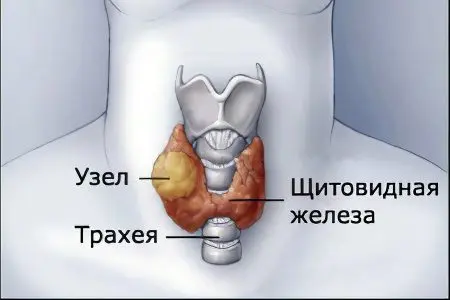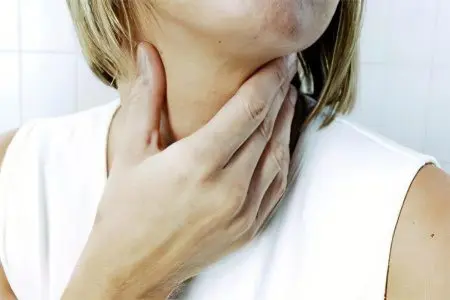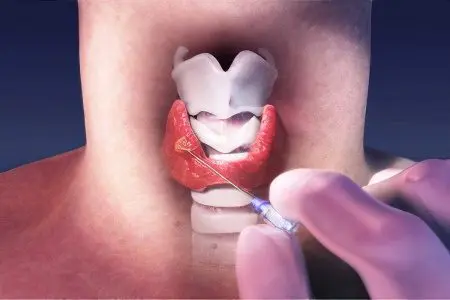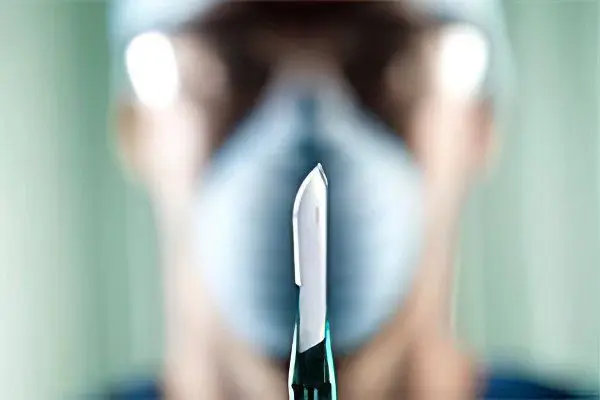Contents
What does a thyroid nodule mean?
Overview

A node in the thyroid gland is the result of a physiological endocrine process of transformation and compaction of individual tissue fragments without visible growth of the entire organ.
Contrary to popular belief, the formation of nodular changes in the thyroid gland is not such a rare occurrence. It occurs everywhere, as a rule, women suffer more often than men due to the instability of the hormonal background.
According to statistics, about half of all women have thyroid nodules after the age of 50, and at a later age this figure rises to 70%. Men are also susceptible to this process, however, their nodes are approximately 2,5-3 times less common. In total, on a global scale, we can talk about 25-30% of people with nodular goiter.
Not all people seek medical help, since the nodes in the thyroid gland rarely disturb their “owners”. Therefore, only registered patients are included in the statistical information, but in reality the number can be much higher. Often, nodes are discovered by chance, when a person comes for a routine examination and the doctor performs palpation, or on ultrasound on suspicion of a serious pathology.
It is not always possible to consider the formation of nodular focal changes as a pathological process.
Often, patients, as soon as an endocrinologist detects nodes in the thyroid gland, panic and begin to go to expensive unnecessary examinations, turn to endocrinological centers, resort to alternative medicine, etc. etc.
Seeing a doctor in a timely manner and monitoring your health is the right decision, worthy of praise. However, nodules do not always pose at least some kind of health hazard and are a manifestation of the disease, and even more so, only in isolated cases we are talking about cancer. The malignant nature of the nodules can only be confirmed by a blood test for calcitonin and an accompanying thyroid puncture.
To better understand what the nodes of the thyroid gland mean, you need to know the anatomy of the organ and, based on this, consider the mechanism for the formation of nodes.
Anatomy of the thyroid gland and the mechanism of formation of nodular changes
The thyroid gland is an unpaired endocrine organ. It is located at the front of the neck and covers the esophagus and trachea. Its shape resembles an insect – a butterfly. The task of the thyroid gland is to provide the basis for a normal metabolism. Energy metabolism and the work of the autonomic nervous system, which regulate processes beyond human control, are impossible without specific substances (hormones) of the thyroid gland. Figuratively speaking, the thyroid gland is the heating system of a multi-storey building.
In the structure of the organ, the right lobe, the left lobe and the isthmus in the central part are distinguished. Most of the thyroid tissue consists of special thyroid cells that produce the necessary hormones. Bubbles-follicles are included in the cell structure, which accumulate a colloidal solution.
Colloid – it is a thick and viscous liquid, which includes a specific protein TG (thyroglobulin).
The thyroid gland, due to the enormous load, has a branched and well-developed system of blood vessels. In the vast majority of cases, the mechanism of node formation lies in the hyperfunction of individual thyrocyte cells. They begin to more actively accumulate thyroglobulin, storing it in the colloid. As a result, the walls of the follicles thicken, and in this part of the thyroid gland, the tissue becomes denser. An increase in thyrocyte activity to pathological levels may be associated with excessive blood supply due to iodine deficiency, or with head or neck injuries. For the same reason, nodes can form as secondary manifestations if the patient has spinal disorders. Nodular changes in the thyroid gland are often found in patients with osteochondrosis.
Thus, nodes in the thyroid gland can mean:
The presence of a pathological process of beginning hyperfunction of an organ or malignant degeneration of its tissues;
The onset of euthyroid status, when the organ is functioning normally, but is on the threshold of the disease. With the onset of the status, both goiter and the occurrence of a malignant tumor (extremely rare) can be expected;
Age or compensatory changes. Since a person lives in an unfavorable environment, the thyroid nodes form as compensatory units to capture more iodine from the circulatory system and create a protective barrier. In older people, we are talking about malfunctions of the thyroid gland against the background of hormonal imbalance, which can be considered as a variant of the norm, but it is necessary to consult a doctor for any formation in the endocrine organ;
Secondary manifestations against the background of head or neck injuries, as well as congestive processes in the collar region.
Symptoms of thyroid nodules

The standard symptoms of the disease are the same for both men and women.
By themselves, nodular changes in the thyroid gland in most cases have neither mechanical nor biochemical manifestations. The patient does not notice them. When a single node or a group of nodular formations occurs, the doctor usually diagnoses “nodular goiter”.
Experts distinguish three forms of goiter:
diffuse;
nodal;
Diffuse-nodular.
The nodular form, unlike others, is just dangerous because of the absence of symptoms, while seals may indicate the presence of a serious illness. In the vast majority of cases (about 85-90%), the nodular form occurs in women. Demographic groups 12 to 18 years old (puberty), 18 to 50 are most at risk. At a later age, there is already a multinodular goiter. Almost always, nodal changes indicate the presence of some additional pathological process associated with impaired hormone production.
Changes in the thyroid gland here can play the role of both cause and effect. So, in 40% of cases in women, the nodes entail the occurrence of a benign tumor – uterine fibroids. This is the reason. And if there is a pathological focus of inflammation in the throat or neck, the nodes act as its consequence.
Typical symptoms are observed only if the pathology is of a mixed nature, and the general growth of organ tissues is added to the nodes, or when the process is malignant and has reached stage 2-3.
The characteristic manifestations of the diffuse nodular form fall into two categories.
Biochemical or hormonal symptoms
They are associated with the growth of the organ as a whole and with the formation of unevenly growing seals – nodes. In this case, their growth is more active.
Even with an increase in the number of thyrocyte cells, the thyroid gland may not produce enough hormones. A variant with a normal level of production is possible, then they talk about euthyroid diffuse-nodular (or nodular) goiter. The most common hyperfunction occurs when an organ synthesizes too much active substance, and its concentration in the blood has a toxic effect on the body.
Manifestations with reduced hormone production:
Decreased metabolic rate. When the thyroid gland produces little hormones, the metabolism slows down. The body is in a “slowed down” state. The patient is rapidly gaining weight. Body temperature periodically drops to levels from 35,5 to 36 ° C;
Disorders of the excretory system. The kidneys stop doing their job. The body retains water in the cells in order to maintain the balance of salts and water (homeostasis). For this reason, severe swelling occurs in the morning or in the late afternoon, which subside very slowly;
Malfunctions in the reproductive system. The level of libido decreases, the reproductive function of the body suffers (menstrual cycle instability and the inability to get pregnant for a long time in women, impotence and reduced motor activity of spermatozoa in men);
Instability in the functioning of the digestive tract. May present with diarrhea or constipation. In some cases, both alternate;
Pathological changes in the functioning of the nervous system. The patient constantly wants to sleep and feels overwhelmed. Emotional reaction to external stimuli drops sharply, depressed mood prevails. Prolonged depressive states are possible. In addition, memory, attention, mental activity and intellect suffer;
Fragility of connective and integumentary tissues. Bones and nail plates become brittle, hair roots become weak, resulting in baldness. The skin becomes very dry.
Problems with the cardiovascular system. The heart rate slows down (bradycardia), blood pressure drops.
Symptoms of increased hormone production

The reverse picture is observed if the thyroid gland synthesizes too many hormones. In this case, hyperthyroidism occurs, and, as a result, thyrotoxicosis. With it, the rate of metabolic processes increases many times, and the body itself, under the influence of excess thyroid hormones, experiences intoxication.
Manifestations with increased production of hormones:
Acceleration of metabolism. No matter how much food the patient consumes, weight gain is not observed. On the contrary, there is a decrease in body weight. The temperature periodically rises to 37-39 ° C for no apparent reason;
Hyperactivation of the nervous system. Psychomotor activity grows, the person becomes irritable and easily excitable. A common symptom is insomnia;
A characteristic external sign is the protrusion of the eyeballs (exophthalmos).
Trembling of fingers, hands and head;
Changes in cardiovascular activity. There is an increase in blood pressure (secondary hypertension may develop against the background of toxic goiter). Even in the absence of physical activity, the heart rate can reach 120 beats per minute;
Disorders from the digestive tract. Diarrhea and constipation, abdominal pain for no apparent reason;
Increased secretion of products of sweat and sebaceous glands. Because of this, the skin becomes overly hydrated and oily.
Severe changes in all systems and organs occur only in the late stages of thyroid diseases.
Nodular and diffuse-nodular goiter (starting from the 3rd stage according to the practical five-stage classification) also have mechanical manifestations associated with compression of the surrounding organs – the esophagus and trachea suffer.
Nodular goiter most often exists in the euthyroid form, and hormone synthesis is at a normal level.
Mechanical manifestations against the background of normal production of thyroid hormones
These include:
Discomfort in the throat and neck. They can be bursting or pressing in nature. Pain is usually absent or insignificant;
Causeless cough;
Shortness of breath in the first stages and frequent attacks of suffocation in the last stages of the disease;
Sore throat;
Hoarseness or hoarseness of voice. With a significant size of the nodes, complete paralysis of the vocal cords and the disappearance of the voice are possible;
Difficulty swallowing food due to squeezing of the esophagus by knots;
External cosmetic manifestations. The defect looks like a lump noticeable when swallowing or like a huge growth that completely changes the shape of the neck and gives the person’s throat a look similar to a bird’s goiter.
A nodular formation in the neck can be injured by careless human actions or by a drop in blood pressure. In this case, hemorrhage occurs in the nodular tissue. It is accompanied by swelling in the goiter and a slight increase in body temperature.
These external manifestations are threatening and frighten the patient, in connection with which he goes to the hospital. However, in reality, there is no threat to life.
Causes of thyroid nodules

At the moment, there is no exact information about the causes of the development of nodes in the thyroid gland. Scientists and practitioners can only speculate. However, over the years of study, doctors have come to some conclusions and identified factors that affect the mechanism of formation of nodules.
The causes of thyroid nodules can be grouped into four main categories:
The presence of pathological foci and chronic diseases;
Aggressive environmental factors;
Genetic predisposition;
Endogenous factors associated with human activities and habits.
Pathological processes and diseases
There are the following diseases that can cause the appearance of nodes in the thyroid gland:
Adenoma and other tumors of the thyroid gland. They are relatively rare. Adenoma on palpation can be mistaken for a colloidal node, but it has a characteristic round shape and a mobile structure (it feels like a rolling “ball” on palpation). The adenoma forms nodes of various sizes, but is not prone to metastasis. The development of benign tumors has a complex essence and is caused by disturbances in the work of the pituitary gland, which secretes the hormone TSH too actively. Thyroid-stimulating hormone “spurs” the thyroid gland, as a result of which the tissues of the organ grow unevenly. Adenoma during development provokes a bright complex of signs resembling the symptoms of hyperthyroidism. For this reason, an inexperienced specialist may take the tumor for a toxic diffuse nodular goiter and prescribe the wrong treatment. Adenoma can be detected only with the help of puncture and ultrasound;
Malignant neoplasms. Of all clinical cases of thyroid nodules, cancer is no more than 0,8-1,5%, but has the most life-threatening symptoms and consequences. The main forms are medullary, papillary and follicular, they are extremely difficult to treat and diagnose;
papillary cancer forms nodes prone to germination deep into the body. The tumor can reach a significant size (up to 6-10 or more cm in diameter). Unlike an adenoma, which is encapsulated by fibrous tissue, a cancerous tumor is not encapsulated. It is difficult to detect on palpation, since it can be located behind the formed colloidal node. It does not move on palpation. It grows slowly and usually poorly metastasizes to the surrounding nodes of the lymphatic system, the nearest organs and lobes of the thyroid gland;
Follicular cancer in its shape and structure it resembles the papillary form, but differs in a more negative prognosis. Like a papillary tumor, it tends to grow slowly and metastasize poorly, but since secondary cancer cells diverge throughout the body not with lymph, but with blood flow, metastases settle even in distant organs: lungs, liver, etc. It is almost impossible to determine the follicular form of cancer clinically therefore, if a node biopsy shows the presence of a follicular adenoma, the doctor simultaneously suspects a possible malignant oncology, because cytological examination does not allow them to be distinguished;
Medullary cancer not determined by palpation in the early stages. In more advanced forms, the tumor is palpated as a dense immobile formation. It is formed from a different form of cells than the previous species, therefore it is determined by an analysis of calcitonin;
Pituitary tumors. Both malignant and benign are prone to increased activity of the endocrine organ and increased synthesis of TSH. As a result, the thyroid gland begins to grow and produce more hormones;
Thyroiditis. Autoimmune diseases (such as Hashimoto’s thyroiditis) can cause both diffuse and nodular thyroid pathologies. The formation of nodes in this case is observed relatively rarely. The reason is an immune reaction in which lymphocytes produce antibodies against iodine-containing hormones and thyrocyte cells. This is usually due to a genetic defect;
colloid production. If cells produce specific substances too actively (for example, during hormonal changes), colloid nodes may develop. They are the most common (almost 100% of cases) and do not have any dangerous consequences. However, the presence of colloid nodes may indicate euthyroid status and the occurrence of severe thyroid disease in the future. Therefore, even if the cause of the node lies in this, the patient should regularly go for examination to the endocrinologist.
Aggressive environmental factors

Deficiency of iodine salts. All iodine entering the body is spent on the synthesis of iodine-containing hormones, which are produced only by the thyroid gland. A person consumes iodine in the form of salt and also with water.
Many regions of the planet are poor in natural iodine, so preventive actions are being taken to compensate for the deficiency (salt is iodized, etc.). There are such zones in Russia and Ukraine. The entire Central and Eastern Europe (including Poland, the Czech Republic, etc.), as well as the countries of the Asian region, are at risk.
When the intake of this microelement is not enough, the thyroid gland tries to make up for the deficiency by building up tissues for more efficient intake of iodine from the blood. Most often, growth occurs unevenly, and seals appear on the “body” of the organ.
If the reason lies precisely in this, nodal changes are combined with diffuse ones, which only aggravates the course of the disease and worsens the possible prognosis.
Selenium deficiency. Few people know that selenium plays no less a role in the normal functioning of the thyroid gland than iodine. With the participation of a selenium-containing enzyme, T4 (tetraiodothyronine) is transformed into a more active T3 (triiodothyronine), without which energy metabolism is impossible.
Unfavorable ecology. Separate parts of the thyroid gland can thicken and form nodes when exposed to adverse factors. It’s kind of a defense mechanism. Particularly destructive are nitrate salts, which are rich in the fruits and vegetables we consume, as well as heavy metals (lead, etc.).
An unfavorable factor is the increased background radiation. Particularly destructive in this respect isotopes of radioactive iodine, which are present in abundance in areas prone to radioactive contamination (due to man-made disasters or nuclear tests). All this iodine enters the tissues of the thyroid gland and has the most negative effect.
Genetic predisposition
Genetically, neither goiter, nor even tumor formations, are transmitted. Even during intrauterine development, the child receives certain features of the body from the parents: metabolic rate, features of the immune system, etc. The predisposition of the child to the appearance of thyroid pathologies depends on these characteristic features, but it is not at all necessary that the disease manifests itself in the phenotype.
Endogenous factors
They include:
Substance use. Cigarettes, alcohol, and drugs trigger an immune response that causes thyrocytes to proliferate and increase in number. As a result, knots-seals are formed in the structure of the thyroid gland;
demographic factors. Knots in men are extremely rare. Therefore, as soon as they are detected, endocrinologists suspect tumor processes. Women suffer more often, especially in old age;
Stressful situations. They cause a variety of problems with the gland, including nodular formations;
Pregnancy and the period of hormonal instability. During hormonal changes (puberty, pregnancy, postmenopause), the thyroid gland works “for wear and tear”, and failures may occur.
Why is a thyroid nodule dangerous?

The question should be put in a different way: is a thyroid nodule dangerous at all? Endocrinologists do not give the only true and unambiguous answer.
With the development of technology and the increasing availability of ultrasound diagnostics, nodes on the thyroid gland began to be found in almost the majority of patients, which puzzled doctors and actualized this problem. Considering that in most cases the knot is nothing more than the result of a temporary failure and “confusion” of the thyroid gland and is of a colloidal nature, there can be no talk of any danger. Colloidal nodes do not grow and do not degenerate into tumors.
As already mentioned, in some cases they may indicate the presence of a euthyroid status, when the disease is just beginning, but, figuratively speaking, it is not yet known exactly which one. Even in this case, the nodules themselves do not pose a danger. The only thing that is required from the patient is to undergo regular examinations with a doctor.
In the case when the cause of the nodes lies in benign tumors, the formations can pose a danger to health and life only in the last stages. However, fortunately, the growth of benign neoplasms is extremely slow, and by the time the node becomes dangerous, even the most inexperienced doctor will understand what is the root of the problem. In the last stages, adenoma and other tumors provoke severe damage to the cardiovascular system and poisoning of the body with thyroid hormones. Therefore, one should not hesitate to go to the hospital and treat.
Oncological neoplasms of the thyroid gland are extremely rare, but represent the greatest danger. Such nodes are quite difficult to diagnose, even a cytological examination is not always informative, but they respond well to treatment even in the presence of metastases. The only exception is medullary cancer, which successfully resists chemotherapy and radiation treatment in the last stages of development. Thus, only in rare cases, nodular formations pose a danger to human life and require treatment.
Can a thyroid nodule dissolve?
Often on the net you have to stumble upon articles from the category of “how to cure …”. There are also materials that offer alternative medicine recipes with a guarantee that nodules on the thyroid gland will resolve.
Similar tips are replicated by the thousands all over the Internet, but they have extremely low information content.
It must be clearly understood that nodular formations can be of a different nature. Only those nodes that are not palpable (up to 6 mm) are capable of self-elimination, but in this case the person does not even know about their existence. Such nodes occur at a zero degree of goiter development. Larger formations, even those of a follicular nature (colloidal) do not dissolve and “neighbor” with a person throughout life, without causing discomfort.
The only exceptions are tumor formations that have been cured conservatively or with the help of a surgeon’s intervention. However, there is no need to talk about “resorption” here.
Thus, the node in the thyroid gland cannot dissolve if it has reached the size at which it is successfully palpated.
Diagnosis of thyroid nodules

An integrated approach is used to identify nodal changes in the organ. Doctors have at their disposal a lot of instrumental and laboratory diagnostic techniques.
Initially, as a rule, palpation and ultrasound are used to assess the size of the formations.
Palpation
Palpation of the thyroid gland is used by the doctor on site during the examination.
To palpate an organ, three different methods are used:
Doctor and patient are face to face. The thumbs of the right and left hands are superimposed on the surface of the cervical (thyroid) cartilage. The rest are wound around the neck or located on the shoulders. The patient swallows and at this moment the doctor makes movements in a vertical plane to assess the size and structure of the thyroid gland.
The doctor stands on the right side of the patient. To relax the muscles of the collar zone, the patient tilts his head forward. The doctor grabs the neck behind one of the hands, and with the other hand palpates the thyroid gland.
The location of the doctor is at the back. He puts the thumbs of his right and left hands on the back of the neck, and with the rest of his fingers he probes the thyroid gland.
Palpation is not sufficiently informative and accurate manipulation, but it allows the specialist to draw initial conclusions about a possible diagnosis. This type of examination requires high qualifications from the endocrinologist.
Also, the problem is the examination of patients with some anatomical features:
If the patient is very thin or has a long neck. In this case, the thyroid gland will be palpable even in the absence of pathologies. An inexperienced doctor may take one of the lobes of the gland for a knot;
In some patients, the thyroid gland may have an atypical location: higher or lower than usual;
In overweight people, iron can be covered with a fatty layer, which will be falsely perceived as a knot;
If the patient’s neck is short and wide, the doctor may not notice the nodules, because. surrounding muscles interfere with palpation;
In some cases, there is a deeper than usual occurrence of the thyroid gland.
Thyroid ultrasound
An ultrasound examination of the patient is carried out in order to assess the size of the node, its structure and the development of the vascular system. With the help of ultrasound, it is possible to detect formations ranging in size from 1 millimeter in diameter. In some situations, already at this stage, a qualified diagnostician can establish the malignant nature of the neoplasm.
It is pointed to:
An overdeveloped system of vessels supplying the node;
Uneven structure of thyroid tissue;
Black or dark gray color of the node on the monitor of the ultrasound machine.
As soon as such signs are detected, palpation of the nearest lymph nodes is necessary. With the most common form – papillary cancer – the lymph nodes increase already in the first stages of the development of the disease.
To better understand the nature and dynamics of the process, 4 more methods are applied:
Analysis of venous blood for the concentration of hormones and specific antibodies;
Radioisotope study (scintigraphy);
Computed and magnetic resonance imaging;
Puncture biopsy.
Blood test
If the doctor found nodes during palpation of the thyroid gland, tests are prescribed to detect the concentration of specific substances in the venous blood.
In this case, the standard list of indicators must include:
Triiodothyronine (T3) in a free state;
Tetraiodothyronine (thyroxine, T4) in a free state;
Thyrotropic substance (TSH-hormone);
AT (antibodies) to thyroperoxidase to exclude the autoimmune nature of the disease.
Calcitonin
Calcitonin is of the greatest importance in the diagnosis of thyroid nodules. It is a typical oncomarker of medullary cancer, and when the concentration of this substance in the blood is higher than normal even by a fraction of a percent, a set of additional examinations should be immediately carried out to exclude or confirm a malignant tumor.
The level of thyroid-stimulating and pituitary hormones in the blood indicates the presence of hyper- or hypofunction of the thyroid gland.
Tomography
Computed or magnetic resonance imaging is performed only with a complex (for example, retrosternal) location of the nodules, since in this case they cannot be seen on ultrasound.
Isotopic research
Designed to identify the source of increased or insufficient production of thyroid-stimulating substances. The essence of the scintigraphy procedure is the introduction of a special substance into the patient’s bloodstream – an iodine isotope (mass number 123) or technetium.
The marker with blood flow enters the thyroid gland, and after a certain time interval (depending on the study, 2-6 or 12-24 hours), the patient is placed under the gamma scanner.
Since both substances are radioactive, the recorder displays a kind of map showing the functioning of individual parts of the thyroid gland. The so-called “cold” (not producing hormones) nodes and “warm” (producing an excess of thyroid-stimulating hormones) are revealed.
Puncture of the thyroid gland

Puncture biopsy of the thyroid nodule is aimed at taking biomaterial from the formation for subsequent histological examination. Its main task is to determine whether the node is malignant or not.
This examination is prescribed in cases where the node has a diameter of 1 cm or more.
Even if the nodes are smaller, they are punctured in the following situations:
In the anamnesis of relatives there is oncology of the thyroid gland;
The patient has been exposed to radiation;
Ultrasound examination suggested the presence of cancer.
With an accuracy of 90%, a biopsy allows you to establish the origin of the node. The exception is the follicular form of cancer, which is no different from follicular adenoma. Therefore, when detecting follicular neoplasms, the presence of oncology is presumed.
How is a puncture done? Thyroid biopsy is practically painless and minimally invasive, so patients should not be afraid of this manipulation. Puncture of the thyroid gland is carried out exclusively under the control of ultrasound, since only the visualization of the process can guarantee accuracy. Nodes can be extremely small. For biopsy, small-diameter needles and syringes with a volume of 10 milliliters or more are used. The small diameter of the needle minimizes pain, which is why the study is called a fine needle biopsy.
The procedure is carried out within a few seconds, usually no anesthesia is required. In some cases (if the patient has sensitive skin), local anesthesia with special creams is used. In some institutions, doctors resort to anesthesia, but the risk in this case is unreasonably high. The biopsy takes about a quarter of an hour. Most of the time is spent on bureaucratic procedures, such as patient registration. The examination does not require special preparation. The patient can follow their normal daily routine both before and after the puncture.
Procedure for the procedure:
The patient lies face up on the table;
To ensure relaxation and full extension of the neck, necessary for easy access to the thyroid gland, a pillow is placed under the back;
The skin over the injection site is treated with an antiseptic composition and, if necessary, an anesthetic;
The area of manipulation is delimited by a sterile napkin;
Ultrasound diagnostics is carried out to clarify the localization of the nodular formation or several formations. To prevent the entry of pathogenic bacteria and viruses into the body, a disposable sterile patch is put on the nozzle of the ultrasound machine;
Under the control of the ultrasound machine, a needle is inserted into the seal. Biological material is taken;
The needle is removed, and the injection site is again treated with an antiseptic.
A biopsy performed in violation of the technique may be uninformative. The same result is possible if the nature of the knot is ambiguous. In such a situation, the doctor recommends surgical intervention. According to statistics, the number of results of a fine-needle biopsy of the thyroid gland that do not carry the necessary information is approximately 7% of all cases.
Treatment of thyroid nodules

Thyroid nodules do not require treatment in all cases. Most often, the essence of medical care is to control the patient’s condition.
A course of therapy is necessary only in cases of:
If the knot disfigures the patient’s appearance (represents a serious cosmetic defect);
Promotes hyperthyroidism (excessive synthesis of hormones);
Causes discomfort and reduces the quality of life.
All methods of treatment of thyroid pathologies (including nodular) include:
Surgical intervention;
Drug treatment (conservative therapy).
A separate item should be allocated minimally invasive therapeutic procedures.
Conservative therapy
Conservative treatment of nodular inclusions rarely gives the desired effect, and is rarely used on its own. Colloidal nodes do not need to be treated at all. Those nodular inclusions that do not affect the production of thyroid hormones do not require correction.
Special therapy is needed in two cases:
Hyperfunction of the thyroid gland as a result of nodal changes;
Or her hypofunction.
Drug treatment is carried out by two groups of drugs:
Synthetic thyroid hormones. Active substances contribute to the normalization of hormonal levels. The course of treatment lasts up to a year. Despite the fact that this method is actively used in our country, its effectiveness is extremely low. In addition, thyroid drugs cause serious side effects, among which there may be manifestations similar to hypo- or hyperthyroidism.
Iodine-containing preparations. They are used only for hypofunction due to iodine deficiency in the body. In all other cases, their use is either useless or even dangerous.
Minimally invasive treatment methods
Sclerotherapy of thyroid nodules with ethanol
This technique has been known since the mid-80s of the last century, and today is one of the most studied. Its clinical effectiveness in the fight against cystic-shaped (including liquid content) nodular inclusions has been proven. The use of sclerotherapy is allowed only for the treatment of benign formations. Prior to manipulation, it is important to resort to a biopsy to confirm the nature of the node.
The essence of the method consists in introducing ethyl alcohol at a concentration of 95% into the cavity of the nodular inclusion. If the formation is filled with liquid, it is preliminarily drawn out. Ethyl alcohol enters the node and destroys its tissue. Due to the fact that the nodal structure is encapsulated by a fibrous membrane, alcohol does not get on other tissues of the organ.
Studies show that the effectiveness of the technique grows in proportion to the volume of alcohol introduced into the node. However, it will not work to introduce a lot of liquid in one session of therapy, otherwise the inclusion may break and the alcohol will flow out, damaging the surrounding tissues.
Side effects from an incautiously performed procedure may include swelling of the vocal cords and pain.
Destruction of thyroid nodes with a laser
The method was actively used ten years later than sclerotherapy, in the 90s. It was invented by scientists from Russia. Destruction is also used to eliminate benign formations that cause compression of surrounding organs and disfigure a person’s appearance. This technique is ineffective against knots with liquid content, it shows itself best in the fight against dense knots.
The essence of the method. The place of manipulation is treated with an anesthetic and an antiseptic solution. A thin puncture needle is inserted into the nodular focus. A powerful LED is passed through the neck and the lumen of the needle. Thermal energy is transferred to the node through the diode, as a result of which the node is heated to destructive levels.
When calculating the time, it is necessary to proceed from the ratio: “1 cm of pathological tissue is destroyed in 7-9 minutes.” Therefore, the procedure can be quite lengthy (up to an hour or a little more). It is carried out under the control of an ultrasound scanner. Rapid manipulation at peak laser power will not produce an effect, since with a sharp jump in temperature, a node destruction site of only a few millimeters will form, which coagulates and does not spread further.
Laser destruction is practically painless, does not require preparation and a period of rehabilitation. The technique is suitable for the destruction of nodular inclusions with a diameter of up to 4 centimeters inclusive. Occasionally, complications in the form of inflammation of the neck muscles are possible.
Ablation of thyroid nodes with radiofrequency radiation
A relatively new method of treatment, which is used to eliminate benign nodular structures with a diameter of more than 4 centimeters. Ablation is technically difficult, so the patient needs to be placed in a hospital for up to two days. The procedure itself lasts no more than an hour. Not suitable for dealing with fluid-filled nodules. The effect is achieved in 2-3 months. The complete disappearance of the node – after six months.
The essence of the method consists in exposing altered follicles and thyrocytes to high-frequency radiation, which is produced by a special generator. Cellular activity stops gradually, so the result is not achieved immediately.
Operative therapy

It is used in extreme cases. Absolute indications for surgery include:
Tumor malignant neoplasms;
Tumors of unspecified origin;
Rapid growth of nodes;
Plurality of seals;
thyroid cysts;
Large knots (diameter over 8 cm);
Atypical location of nodal structures (for example, retrosternal).
The essence of the surgical intervention is to excise the tissues of the nodular formations with their complete removal, or to the complete or partial removal of the thyroid gland itself.
The latter is practiced in the case of malignant processes and entails formidable complications.
Removal of the thyroid gland is the most drastic measure. However, unskilled doctors often prescribe thyroidectomy at the slightest suspicion of a malignant tumor. The operation is justified only in one case: if the tumor is really present and has grown deep into the tissue of the organ. Then you can not do without removing the entire thyroid gland or part of it. The main reason for surgery is follicular or papillary cancer.
But even the removal of the gland does not guarantee a complete cure and the absence of relapses. Manipulation should be prescribed strictly according to indications, since it has a huge number of formidable consequences that significantly reduce the quality of life. The intervention affects the female body, which is more difficult in terms of maintaining the correct hormonal background, especially strongly. There are problems with the menstrual cycle, the onset of pregnancy.
Both women and men who survive such an operation fall into a lifelong dependence on synthetic thyroid hormones. However, fortunately, surgery, and even more so the complete removal of the gland, is extremely rare. Most of the ailments associated with the thyroid gland, whether they are nodes or diffuse pathologies, are eliminated by well-chosen conservative methods.
Surgitron
Any surgical intervention is always highly traumatic. Because of this, the period of postoperative rehabilitation increases significantly. In recent years, surgical instruments of a new generation have become widespread in surgery (including operations on the thyroid gland). One of these is the Surgitron radio wave hardware complex.
The operation of the device is based on the destruction of cellular structures by high-frequency waves, due to which the tissues in the affected area do not receive additional injuries, as when working with a scalpel (when using a scalpel, tissue necrosis occurs). There are also no burns as when using a coagulator.
This method of operations promotes rapid healing and eliminates additional postoperative complications and pain. The device is used for operations in endocrinology, gynecology and other branches of medicine.
Prevention of the development of thyroid nodules

The basis of preventive measures to prevent the occurrence of nodular foci are three components:
Proper nutrition;
Rejection of bad habits;
Regular check-ups with an endocrinologist.
Diet
One of the main causes of thyroid diseases is malnutrition and deficiency of essential trace elements (iodine, selenium). Individuals who are not prone to thyroid diseases, or those who have confirmed euthyroid status, definitely need to adjust their diet.
Every day you need to consume seaweed, there should be fish on the table (hake is the richest in iodine), shrimp if possible, as well as cod, beets and garlic.
It is equally important to consume foods rich in selenium, such as Brazil nuts and dates.
Rejection of bad habits
Bad habits: smoking, drinking alcohol and drugs, lack of sleep, etc. sooner or later will manifest problems with the thyroid gland. Nodular formations form as a protective barrier, but this does not happen immediately. It can take years for the pathology to develop, and all this time it will not make itself felt.
Do not expect severe consequences. Giving up bad habits will be an additional guarantee of thyroid health.
Regular check-ups with an endocrinologist
They are especially important during puberty in children of both sexes, pregnant women and older women. Although most of the nodes that form due to hormonal changes do not pose a danger to life and health, you can never know in advance whether this formation is benign or not. In addition, many nodes (except colloidal) tend to develop into malignant tumors.
It is advisable not to live in regions with a developed industry (since factories and factories are located nearby, which are a source of toxic air and water pollution), to avoid stress.
Nodular foci in the thyroid gland do not have a gender and are formed in both men and women. However, females are more prone to thyroid nodularity due to a more complex endocrine system. In men, thyroid nodules are rare and suspicious from an oncological point of view.
Symptoms are the same for patients of both sexes and include complex disorders in the work of all body systems. But in most cases, there are no clear manifestations. Independently nodular inclusions of the thyroid gland almost never resolve. For diagnosis, doctors use a variety of methods, both laboratory and instrumental.
The nodes often do not require treatment, but if there are toxic or hypothyroid signs, a course of conservative therapy is prescribed or minimally invasive methods for eliminating the nodes are used. Surgical intervention is an extreme measure, and they resort to it only when there is a malignant process, an excessively large proliferation of goiter, or severe toxic damage to the body.
Like any disease, thyroid nodular pathology is easier to prevent than to treat. You just need to enrich your diet with foods rich in iodine and selenium, as well as give up bad habits and, if possible, minimize stressful situations.









